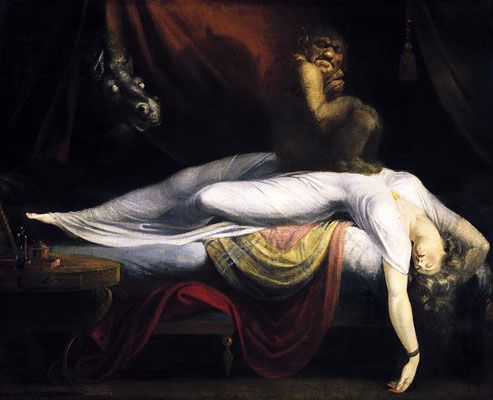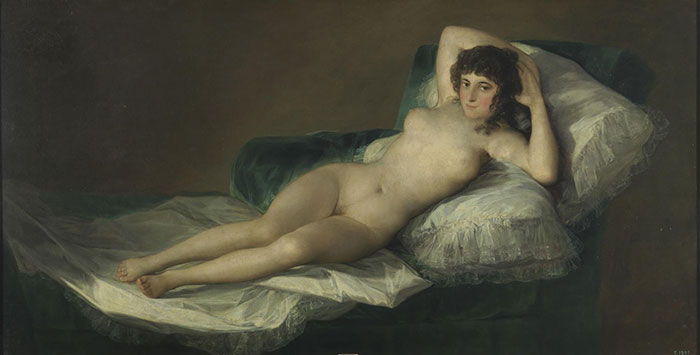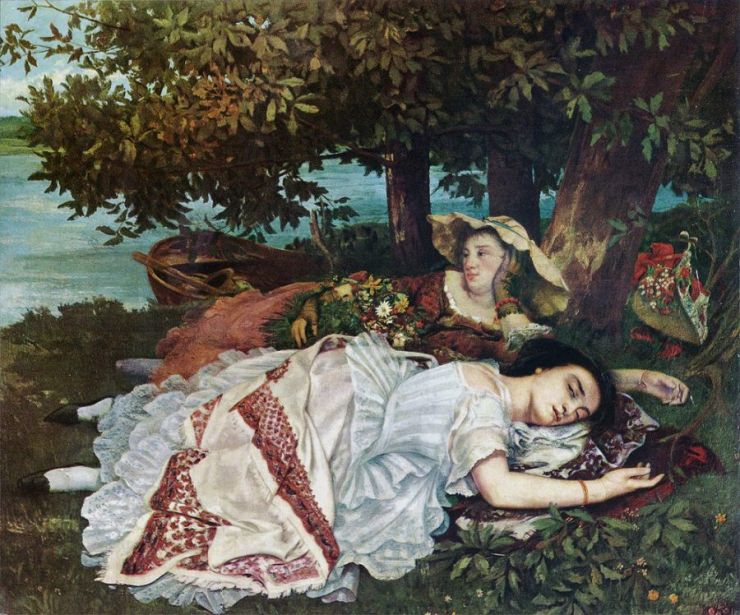Introduction
With this blog, I chose to compare two realist paintings and two romantic paintings. I think realism as a response to romanticism is fascinating and wanted to explore their differences from that perspective. Personally, I like the style of realism because I relate to it more. I enjoy things that are not sugar-coated and I think art of this style is attractive to me because it presents reality without the theatrics.
Romantic Paintings
The first romantic painting I chose to analyze is The Nightmare by Henry Fuseli. This piece was controversial at the time for its sexuality. For this piece specifically, the sexual theme is much harder to dissect because it is not clear if the incubus sitting on her chest is her dream taking physical form or if the incubus intends to have sex with her while she is sleeping. The mare in the back is a mythological creature said to haunt those in their dreams which seems to me to suggest then that the incubus is also meant to be a part of her dream.
No matter the interpretation, the controversy surrounding The Nightmare’s exhibition is understandable and actually intentional. Before this painting, Fuseli was unknown to the world and he hoped to change that with the exhibition of The Nightmare. He was successful in that aim immediately and also historically as this scene is essential to romanticism and inspired many authors, painters, and artists after him.
Characteristically of romanticism, The Nightmare is about a dream, a dream that evokes strong emotions in the viewer. The creatures’ violation of the woman’s space, body, and thoughts is prime romantic subject matter. The draped blankets beneath her and the dramatic positioning of her arm give the painting the theatrics of romanticism.

The second romantic piece I chose to analyze is La Maja Desnuda by Francisco Goya. In English, the title is The Nude Maja. According to Merriam-Webster, a maja is “a Spanish belle of the lower class,” and a belle she is! Her lovely hourglass figure faces the viewer and her eyes draw you in similarly to the gaze of the lady in the foreground of The Young Ladies on the Bank of the Seine. Her flirty gaze makes this painting lively and warm. Her rosy cheeks also imply a recent sexual encounter. She is confident in her sexuality and her skin. This is the type of painting I would have in my home because of her unashamed attitude and captivating gaze.
The history of the painting is convoluted and, at times, unknown. In 1815, Goya was called before the Secret Chamber of the Inquisition of Madrid to verify the confiscated painting was his and explain who commissioned it and why. The Inquisition had deemed the painting immoral and no doubt wanted to investigate the morality of the commissioner. From my limited research, no one is quite sure what happened after Goya testified.

Realist Paintings
The first realist painting I chose is Symphony in White, No. 1: The White Girl by James Whistler. The red-haired woman in the painting is Joanna Hiffernan, his mistress. In my research, I discovered London’s Royal Academy and the French Academy’s Salon rejected the painting because the topic was deemed inappropriate. The combination of the white dress, messy hair, and drooping flower in her hand were interpreted as a loss of innocence. The overall tone of the work is white. There is almost no color variation. Instead of color, Whistler focuses on texture and form. The draping of the curtain behind her, the ruffles and puffs of her dress, and the fur of the bear rug are good examples of the visual texture in this piece. In its entirety, the piece exudes wildness.
Since academies were refusing to showcase his work, Whistler instead exhibited it in the Salon des Refusés, a protest exhibition. The exhibition, organized by Gustave Courbet, featured works that salons had turned away. The White Girl gained Whistler a notoriety he had not experienced from previous works.

The last painting I chose is The Young Ladies on the Banks of the Seine by Gustave Courbet. In its time The Young Ladies was quite scandalous because of the sensuality of the women. The exhibition of the work at the Paris Salon of 1857 caused quite a stir with its depiction of modern uninhibited women in nature.
Ironically, their raw sensuality is precisely how we identify realism in this piece. Candid postures, undergarments, and the eyes of the woman in the foreground are provoking and simultaneously quite literal interpretations of fallen women. The painting was an unwelcome reminder to the salon public that there were working women in Paris who allowed men to pay for delight of being with them. The salon public was not used to viewing sexuality in these terms.

Sources
Kilroe, Ximena. “Francisco Goya Artist Overview and Analysis.” The Art Story. March 6, 2017. Accessed March 25, 2019. https://www.theartstory.org/artist-goya-francisco-artworks.htm
National Gallery of Art. “Symphony in White, No. 1: The White Girl.” National Gallery of Art. Accessed March 25, 2019. https://www.nga.gov/collection/highlights/whistler-symphony-in-white-no-1-the-white-girl.html
Paulson, Noelle. “Henry Fuseli, The Nightmare.” Khan Academy. Accessed March 25, 2019. https://www.khanacademy.org/humanities/becoming-modern/romanticism/romanticism-in-england/a/henry-fuseli-the-nightmare
The Art Story Contributors. “James Abbot McNeill Whistler Artist Overview and Analysis.” The Art Story. March 22, 2016. Accessed March 25, 2019. https://www.theartstory.org/artist-whistler-james-abbott-mcneill.htm
Kaitlyn,
First, ‘The Nightmare’ is actually terrifying. It reminds me of the concept of sleep paralysis, which also terrifies me. The contrast in these wo styles is really stark! something that I’m not sure I would’ve noticed before beginning this course. I find it especially interesting that all of these paintings have women as subject but they are all portrayed so differently. Thanks!
Elizabeth
LikeLike
Hi Kaitlyn, the painting of the nude lady reminded me of the movie “Titanic” where Jack was doing a painting of Rose. Was the “Titanic” movie during the Romantic Era? That is what is driving me to find out. The painting of the ladies on the bank, kind of reminds me of boating, camping and picking berries. The ladies laying down on the “tundra” reminds me of when my family and I were picking berries on a hot day, and after we were done at the end of the day, we sat in a shade resting and cooling off from the hard labor of picking berries.
LikeLike
Your pieces are very interesting! The controversial pieces seem to be common during this period. I found them in realism as well. A lot of realist and impressionist artist seemed to pain the women in the nude.
The Nightmare is terrifying. While reading and taking in the piece, i noticed it is very dark. The woman appears to be almost dead. The position of her body would, at first glance, lead to believe that she is dead and not sleeping. If it hadn’t been for your anazlyzation i wouldn’t have known she wasn’t.
LikeLike
Shock value seems to be the main theme among all these works. I appreciate your discussion of the impact all of these pieces had on their audiences at the time. It shows a rebellion of the classical portrayal of ladies in proper dress and postures. I wouldn’t have recognized the Whistler piece as being among this group of scandalous ladies without your description. What is surprising to me in regards to this piece is the lack of detail on the facial expression in comparison to the others.
LikeLike
Yes! Someone else covered the Romantic style! It seems that many people are not big fans of it, and even you listed it as a style that was not your favorite.
Although there is no evidence to actually suggest it, La Maja Desnuda almost appears to be a study for a future painting involving the female form, especially in the elongated position that the model holds. I am the type of person to prefer modesty (I’ve been known to comment to friends about dresses being too short in a negative way, whereas very few of the people hearing my comments are ever disappointed about the shortness), so the painting was not one that I had the urge to hang on my wall, but I can certainly appreciate the artistic beauty that it portrays.
That being said, I do not think that the subject necessarily looked this way in life. The artist seems to have focused on individual components of the body in portions, so the “connections” seem slightly disjointed. Look at her face: it is quite lovely, as you said, but look how it fits onto her upper body. Her face seems too low on the body, to the point that her neck is hidden or very large. If her upper body were more typical, her chest would not be wide enough to accommodate breasts of the portrayed size, and it would lessen the degree of her hourglass figure, which is very much a focal point of her body.
That is not to say that the painting is bad. I especially love the light in this scene! At the time, soft lighting was not as accessible as it is in modern studios, so the soft ambient light that illuminates the subject and background while focusing on her body is very noteworthy in my eyes. As a brief aside, if I had to guess, I would suppose that the light came through a window with a morning sun, perhaps with the curtains partially drawn to give the impression of illumination from the bottom. Her body position works with the light perfectly, completely lighting her torso but leaving shadows on the legs and arms.
LikeLike